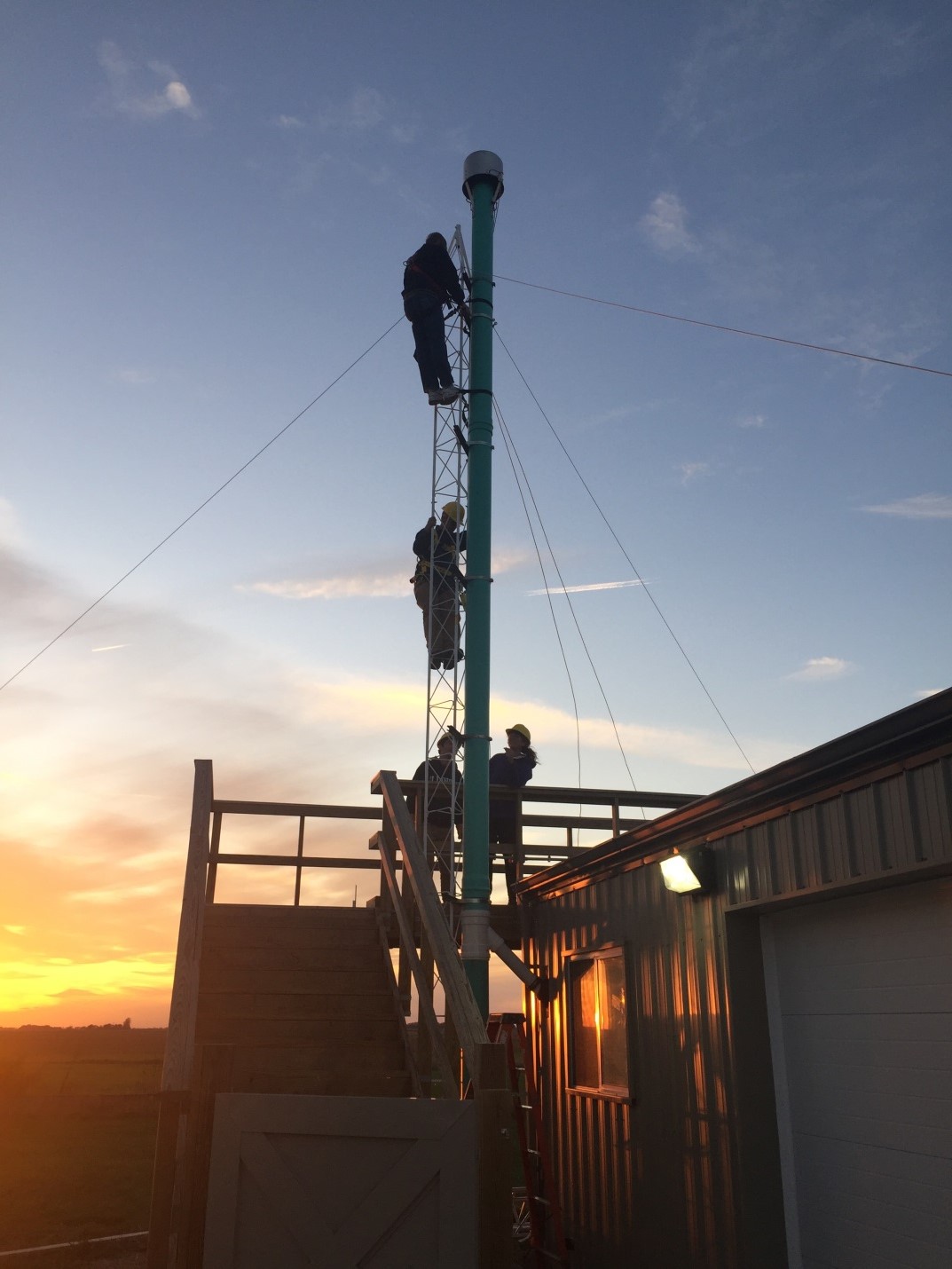Move of Bondville, IL Aerosol System to New Facility
Decemter 15, 2017
Aerosol measurements have been made by the NOAA/ESRL Global Monitoring Division (GMD) at the Bondville Environmental and Atmospheric Research Site (BEARS) since June of 1994. This station is operated by the Prairie Research Institute at the University of Illinois, Urbana-Champaign (UIUC). The urban area of Champaign-Urbana (population 130,000) lies approximately 15 km to the east-northeast of the BEARS, and the dominant climatological winds at the site are southerly and westerly. There are no major urban areas immediately upwind of the station, and the Bondville, IL site has long been considered representative of a rural, mid-continental location.
Ambient aerosols at BEARS are sampled at a height of 10 meters above the surface through a vertically-oriented inlet assembly. Relative humidity is controlled in the sample lines by gentle warming in accordance with World Meteorological Organization / Global Atmosphere Watch (WMO/GAW) sampling protocols. Long-term measurements currently being made at the site include aerosol light scattering, hemispheric backscattering and absorption coefficients over two particle size ranges and at three visible wavelengths, total particle number concentration, and wind speed and wind direction. Multiyear, co-located aerosol measurements that have been discontinued include aerosol hygroscopic growth factor and aerosol filter ionic chemistry. The BEARS station is valuable to ESRL research, as it also hosts measurements from many national and international monitoring programs, including NOAA’s Surface Radiation Network (SURFRAD), the US Climate Reference Network (USCRN), the Interagency Monitoring for Protected Visual Environments Network (IMPROVE), the Clean Air Status and Trends Network (CASTNet), the National Core Pollutant Monitoring (NCore), NASA’s Aerosol Robotic Network (AERONET), Ultraviolet Radiation Monitoring Climatological and Research Network (UV-b), the National Atmospheric Deposition Monitoring Program (NADP), and the Illinois Water and Atmospheric Resources Monitoring Program (WARM).
The NOAA aerosol record at Bondville has just passed 23 years in length, and with a record of this length we can begin to interpret long-term trends. Figure 1 shows a plot of the monthly-average aerosol light scattering coefficient (which can be used as a proxy for aerosol amount) over the duration of the record. The downward trend in light scattering over this period at Bondville is statistically significant at the 99.9% confidence level and follows the same pattern as was found at many other sites in the US1. While our limited set of measurements is insufficient to identify the cause of this trend, it could be related to effective US national and regional pollution control policies. Interestingly, many stations in other parts of the world do not show this downward trend in aerosols. The NOAA Baseline Observatory at Mauna Loa, HI, which is in the transport path of free tropospheric aerosols moving across the Pacific from Asia, shows a statistically significant upward trend in aerosol scattering1.

Over the years the original ‘building’ (a sea container) degraded to such an extent that continuing the measurements were becoming increasingly difficult. The roof leaked, rodents were getting inside, measurement temperatures were unstable, and the working conditions were generally poor for the technicians servicing and maintaining the equipment. Fortunately, in 2016, ground was broken for a new building at the BEARS site that would serve as a new laboratory for a number of research projects and measurement systems. This facility (the Prairie Research Institute’s Bondville Field Research Station) was provided to host long-term monitoring projects by the Illinois State Water Survey and the Prairie Research Institute at UIUC. In late October of 2017, the GMD aerosol monitoring system was moved from the aging, uninsulated sea container to a new temperature-controlled building about 80 meters away.
A team of three GMD researchers (Patrick Sheridan, Betsy Andrews and Jim Wendell), with assistance from colleagues Chris Lehmann and Sybil Anderson at the Illinois State Water Survey, spent a week at BEARS moving the aerosol system. The work began by erecting, anchoring and guying a new 10-meter tower, and, after that was in place, the inlet system was constructed and attached. The aerosol instruments and flow system were then moved from the old location to the new building, and the flow system was completed in place. New calibrations, system checks, and comparisons were performed on the instrumentation in the new location to ensure consistency with the previous measurements. With the new building at BEARS, GMD hopes to be able to continue its collaboration with the Prairie Research Institute at UIUC many years into the future.


References
- Collaud Coen, M., Andrews, E., Asmi, A., Baltensperger, U., Bukowiecki, N., Day, D., Fiebig, M., Fjaeraa, A. M., Flentje, H., Hyvärinen, A., Jefferson, A., Jennings, S. G., Kouvarakis, G., Lihavainen, H., Lund Myhre, C., Malm, W. C., Mihapopoulos, N., Molenar, J. V., O'Dowd, C., Ogren, J. A., Schichtel, B. A., Sheridan, P., Virkkula, A., Weingartner, E., Weller, R., and Laj, P.: Aerosol decadal trends – Part 1: In-situ optical measurements at GAW and IMPROVE stations, Atmos. Chem. Phys., 13, 869-894, https://doi.org/10.5194/acp-13-869-2013, 2013.
